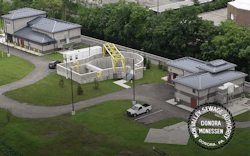A Community Staying Ahead of Regulations
The Mon Valley region of southwestern Pennsylvania has been hit hard in recent years by the downturn of the steel industry, and the local community of just 5,500 households struggled to recover. So, when the Mon Valley Sewage Authority pledged nearly $50 million to update or eliminate its CSOs and improve water quality, people took notice. The decision to proactively address CSOs before regulators mandated controls was a decision that proved to be ahead of its time.
Safer and Simpler Solutions for Chlorination and Dechlorination
Mon Valley installed the Accu-Tab® Chlorination and CleanSlate® Dechlorination Systems as part of its Combined Sewer Overflow Long Term Control Plan.
Partnering with engineering consultants Wade Trim, Mon Valley considered a number of options to address its CSOs including UV treatment and sodium hypochlorite. It was ultimately the all-around technology provided by Accu-Tab and CleanSlate that set them apart.
“They have a positive combination of characteristics—lower upfront capital costs, higher safety potential, and are effective with intermittent treatment typical of CSOs,” said Jason McBride, Wade Trim Northeast Area Lead, Vice President.
Composed of calcium hypochlorite, Accu-Tab tablets deliver a safer alternative than chlorine gas, while providing a more cost-effective solution than the capital costs and maintenance associated with UV systems. CSOs often need to store chlorination solutions for months between storms, and while sodium hypochlorite is an inexpensive and effective disinfectant, its 12-15% potency can drop to as low as 7% depending on storage conditions and timing. In contrast, the Accu-Tab system provides consistent delivery of 68% available chlorine when stored properly, for up to a year.
Working in tandem with the Accu-Tab system, CleanSlate dechlorination tablets take over when the chlorination stage is complete. Consisting of 90% active ingredients, including sodium sulfite and sodium thiosulfite, CleanSlate tablets allow for discharge of water that meets NPDES, Clean Water Act and Tier II Stormwater standards. The CleanSlate dechlorination system uses analogous equipment to the Accu-Tab system for ease of operation and maintenance.
Results
When completed, the Mon Valley’s Combined Sewer Overflow Long Term Control Plan will capture an average of 85% of the flow that enters the combined system during precipitation events each year.
Mon Valley chose to eliminate nine CSO outfalls, build 22,000 feet of new separated pipe, upgrade five pump stations, build equalization tanks and improve conveyance systems, among other improvements. The sewage authority piped its largest CSO to its new Satellite Treatment Plant, which became operational in October 2019. The new treatment location includes multiple separation/filtration steps combined with Accu-Tab chlorination and CleanSlate dechlorination systems.
Mon Valley and Wade Trim want to pass on lessons learned from their performance testing and operator experiences.
“We could be breaking the ice for everybody else behind us,” said Tom Salak, Mon Valley Sewage Authority General Manager.
Click here to learn more about the project and how Accu-Tab and CleanSlate provided the right solution.
Editor's Note: Scranton Gillette Communications and the SGC Water Group are not liable for the accuracy, efficacy and validity of the claims made in this piece. The views expressed in this content do not reflect the position of the editorial teams of Water & Wastes Digest, Water Quality Products and Storm Water Solutions.

